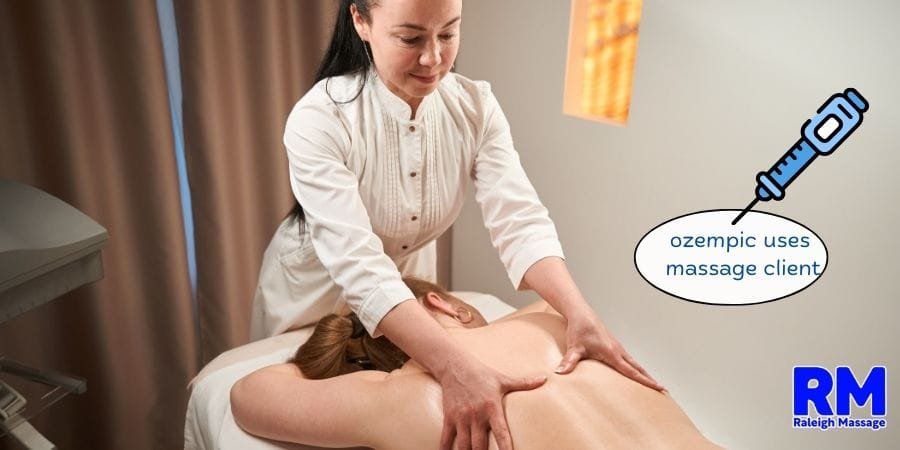If you’re a massage practitioner, your practice can sometimes include working with Ozempic takers for your clients. Ozempic is a prescription medication that is often used in the treatment of type 2 diabetes and for weight loss. What you might not realize, though, is that it can affect your massage delivery too. With working with Ozempic takers, your techniques have to adapt in a way that keeps them safe and comfortable. Let’s explore your options for altering your techniques. Obesity is a growing and increasing trend. The increase in advertising related to food, people’s lifestyle, has played a big role in the increase in obesity. According to statistics, obesity and overweight are an increasing epidemic. Research and study of new ways to lose weight have brought new drugs and new methods to the market. Ozempic or semaglutide is a drug that has been approved by the FDA for the treatment of type 2 diabetes and also to eliminate obesity. Obesity has severe complications and messages for human physical and mental health. The solution of GLP-1 agonists and the production of new types of drugs have created new hope for the fight against obesity. Ozempic is a type of ampoule for slimming and weight loss. A hormone is naturally produced in the body that controls blood sugar and causes weight loss. Ozempic works by mimicking this hormone, which is called GLP_1. This hormone is produced in the stomach after eating and reduces appetite. It also increases the feeling of fullness and improves insulin sensitivity. Ozempic controls blood sugar. This ampoule reduces calorie intake by reducing appetite and feeling full. Ozempic slows down the emptying of the stomach and makes you feel fuller for longer. Ozempic also helps control blood sugar by reducing glucagon production. This drug reduces blood sugar levels, especially in people with type 2 diabetes. This drug can also help people who have not been able to lose weight with exercise and diet. The quality of life of people will change with the increase in weight after taking Ozempic. After losing weight and losing weight, people gain more self-confidence. These ampoules are used as injections. When you visit your doctor for weight loss, he will teach you how to use these injections. Ozempic is injected subcutaneously. The injection site for Ozempic is under the skin of the abdomen, arms, thighs. It is better to change the injection site each time to avoid inflammation and swelling at the injection site. Ozempic is injected once a week. But sometimes the doctor may prescribe a higher dose based on his own diagnosis. The doctor may also change the injection time based on his experience.
Understanding Ozempic and Its Effects
Ozempic works by affecting blood sugar and delayed digestion and can cause a range of side effects, including nausea, dizziness, and dehydration. These can all affect a client’s response to massage in different ways.
One important fact is that Ozempic takers will have low blood sugar. In case they have not consumed any food in a session, they can become dizzy. Check your client first, at all times, and make them report how they’re feeling, whether they have recently consumed any food, and whether they have noticed any reaction towards the medication. Massage is very beneficial for those who use Ozempic for weight loss. Massage reduces the side effects of Ozempic. Ozempic is an anti-diabetic drug and specialists can also use it for weight loss. Like all drugs, along with helping to treat and improve diseases, Ozempic also has side effects. In some people, Ozempic is associated with side effects such as vomiting, constipation, and nausea. Massage can help a lot in reducing the side effects of this drug. Massage can also help reduce a person’s stress. With massage, many toxins are excreted from the human body. People treated with Ozempic feel better after massage than before massage. Massage therapy is one of the ways that reduces the side effects of many drugs. Massage therapy is one of the ways that reduces the side effects of many drugs. Experience and research have shown that this practice has yielded good results in most people. Sometimes, some people experience swelling and allergy symptoms with Ozempic. Massage therapy can help reduce side effects such as swelling after taking Ozempic by helping with blood circulation. Research has shown that weight loss with Ozempic can be only a few pounds in the first few weeks. However, the amount of weight lost in the same people increases over time.
Massage has a great effect on relaxing the muscles and skin of the body after losing weight. With massage, you will see a significant increase in skin firmness and tightening. Sometimes, people who use Ozempic for weight loss experience nervous tension due to rapid weight loss. Massage therapy brings a good feeling of relaxation to people who use Ozempic for weight loss. Massage therapy maintains moisture in the body and improves the feeling of weakness in people who have lost weight. Performing a professional massage can improve fatigue, bruising, and cramps caused by rapid weight loss. Some people feel dry in their skin after using Ozempic and losing weight. For such people, if the massage is accompanied by the use of natural oils, it will have a great effect in eliminating this dryness. After getting a massage, they help to eliminate as many toxins from the body as possible by drinking plenty of water. Sometimes some people experience bloating and gas accumulation in the intestines after using Ozempic. Massage is very effective in improving these conditions. Ozempic is an effective weight loss drug for people who want to lose a lot of weight. After choosing this method of weight loss, the effectiveness and usefulness of massage has been proven by experience.
How Ozempic can help people to loose wheight
These days, Ozempic is known as an effective and well-known drug for type 2 diabetes and weight loss. Ozempic mimics the action of GLP_ 1, a hormone derived from the small intestine. This drug significantly reduces appetite by activating GLP_ 1 receptors in the human brain. These receptors are in parts of the human brain that are responsible for regulating appetite. They cause this part of the brain to receive satiety signals and also slow down the emptying of the stomach, which reduces food intake. This action leads to a greater feeling of fullness and reduces food cravings. This action ultimately leads to weight loss by reducing blood sugar levels and balancing them. Studies have shown that Ozempic significantly reduces the desire to eat in obese people. In one study, they came to the important conclusion that people who took Ozempic ate 60 percent less food than other people. In certain patients, this drug has reduced the risk of cardiovascular events such as stroke or heart attack. This drug allows people to have excellent weight loss by reducing fat and controlling sugar. In 2021, a drug called Wegoy, which was very similar to this drug in terms of composition, entered the market. It was approved by the FDA. This has led to a drug like Ozempic, which is similar to Wegoy, being increasingly used worldwide for obesity. In a study conducted at the Cleveland Clinic, it was stated that Ozempic is not just an appetite suppressant. This slimming pen drastically changes how the body responds to weight loss. Ozempic improves the disease of disorders in fat regulation pathways and weight gain. In addition to affecting these pathways, this drug also changes how the body responds to eating and gaining weight.
How to Adjust Massage Techniques
- Use Gentle Pressure
Clients on Ozempic become sensitive to deep pressure. Dehydration, a secondary effect of the medication, can cause tissue and muscle tissue to become tender. For deep tissue massage, apply lighter, gliding strokes in its place. Relaxation will follow in the client with less tension placed in their body.
- Focus on Hydrating and Perfusion
Since Ozempic will slow down your digestion, bloating and a sensation of fullness at times can occur. Gentle abdominal massage can sometimes ease them, but first, make sure to seek permission from your client. Have them hydrate with water both in preparation and afterward. Hydrating will remove toxins and can settle any nausea experienced.
- Be Cautious with Blood Sugar
A client on Ozempic can have unpredictable blood sugar levels. In the event that they become dizzy and faint, stop the massage immediately. Offer them a sip of water and make them sit down for a break. Having a small snack, for instance, crackers, at your fingertips in case of an attack is a precaution worth taking.
How does massage effect on Ozempic users
Ozempic is a common medication used to treat type 2 diabetes. This medication can control blood sugar levels and has effects on the body that are related to massage. Now, let’s start looking at some of the effects of Ozempic on massage.
One of the effects of Ozempic is to reduce appetite in obese and overweight people. These effects will change a person’s eating habits and affect a person’s energy and mood. These types of changes can affect the way massage services are provided and performed. Some people who have taken Ozempic experience lethargy, low energy, and a feeling of fatigue. This feeling and mood of the client can affect the quality of the massage. Some people who have taken Ozempic for weight loss and slimming have experienced some changes after taking it. These changes are sometimes observed in the condition of the body’s muscles and joints. This type of change can be due to a change in the type of physical activity of the person. This condition can also occur due to hormonal changes. In such cases, the masseur needs to make adjustments to his/her style and techniques. In some people, after taking the course of Ozempic treatment recommended by the doctor, changes occur in the skin. These changes are seen in the form of dry skin. Skin sensitivity and a feeling of tightness and lack of moisture in the skin have been reported. Ozempic can have effects on the tissues of the lower limbs and have a visible effect on the skin of the body. Since a professional masseur has a proper understanding of the skin and how to work on the skin, he/she will notice these changes. So these changes can have a great impact on the performance of the masseur and getting a better experience after performing the massage. Sometimes, side effects such as nausea, diarrhea, vomiting, bloating and swelling are seen after taking Ozempic. These side effects can be very effective in making a person feel comfortable while getting a massage. Another point is that the effects of Ozempic can be completely different in different people and depend on each person’s body.
Safety Tips for Massaging a Client with Ozempic
- Communicate Before and During the Massage
Always start with a conversation. Ask your client if they have eaten, how they’re feeling, and if they have any concerns. Check in during a session regularly. Stop and adjust your technique if, at any point during a session, your client feels unwell.
- Avoid Overwhelming Stimulation
Since Ozempic acts through moisture and digestion, avoid strong techniques such as deep tissue work or strong stretches. Instead, use calm motions that stimulate calm, not stimulation.
- Watch for Signs of Discomfort
If your client feels uncomfortable or dizzy, stop at once. Have them sit up gently and give them water. Tell them to contact their doctor if symptoms don’t go away.
What percentage of Americans are Ozempic users
based on the increasing use of Ozempic for weight loss and slimming, some statistics are available. Today, surveys and statistics show that about 38 percent of people who receive massage in the United States also use other tools and devices along with massage. However, there are still no precise statistics on the use of Ozempic among massage therapy clients. Ozempic is a prescription drug and must be prescribed by a specialist. Its use also requires examination, monitoring and follow-up by the doctor treating overweight people. Obtaining accurate statistics on the number of people who use or have used Ozempic at the same time as receiving massage is currently not available. Because the use of Ozempic among that group of people who receive massage regularly is likely limited. So, its use is under the control of the doctor and the specific conditions of the patient. This specific type of treatment has made it impossible to find accurate statistics on people living in the United States who receive massage and use Ozempic at the same time.
Final Thoughts
Massaging a client taking Ozempic involves additional care and caution. With soft pressure, effective communication, and a grasp of the impact of the medication, a safe and beneficial massage can be delivered. As a precaution, your first concern must always be your client’s welfare, and adapt your techniques appropriately.In general, we conclude that Ozempic is a specialized and new drug. This drug is used to treat type 2 diabetes and help lose weight. This new drug is being used increasingly in the world among this type of people. The good results and effectiveness in eliminating obesity and overweight have encouraged people to buy and treat their problem with this drug. Ozempic mimics the function of GLP_1, which is a hormone derived from the small intestine. This drug greatly reduces appetite by activating GLP_1 receptors in the human brain. These receptors are in parts of the human brain that are responsible for regulating appetite. When Ozempic binds to these receptors, it causes this part of the brain to receive satiety signals. It also slows down the emptying of the stomach, reducing food intake. This function leads to a feeling of fullness and greatly reduces the desire to eat. It also reduces blood sugar levels and balances them, ultimately causing weight loss. Studies have shown that Ozempic significantly reduces the desire to eat in obese people. In one study, it was concluded that people who took Ozempic had a 60% lower desire to eat than other people. In certain patients, this drug has reduced the risk of cardiovascular events such as stroke or heart attack. This drug allows people to have excellent weight loss by reducing fat and controlling sugar. Ozempic is not just an appetite suppressant. This slimming pen drastically changes the way the body responds to weight loss. Ozempic improves the disease of disorders in the pathways that regulate fat and overweight. In addition to affecting these pathways, this drug also changes the way the body responds to eating and gaining weight. This drug is used subcutaneously. Despite its benefits, the use of Ozempic may be associated with side effects or drug interactions that require careful control, attention, and supervision by a physician.
FAQ's for Ozempic uses massage clients
1. Can I give a deep tissue massage to a patient who is taking Ozempic?
It’s best not to apply deep tissue massage to Ozempic clients. Dehydration and sensitization of the muscles can occur with the medication, and deep tissue can cause sore and aching feelings. Instead, apply soft techniques for circulation and relaxation. Monitor your clients regularly to make them comfortable during a session.
2. Should I ask my client whether she ate beforehand?
Yes, it’s worth asking about. Ozempic can cause blood sugar to drop, and clients can become dizzy and feel weak. In case they haven’t eaten, during the massage session, they can become uncomfortable. Ask them to have a balanced blood sugar level during the session and recommend a light snack beforehand.
3. What can I do when my client experiences nausea during a massage?
If your patient feels nausea, stop the massage immediately. Have them sit down and have them sip a little water. In case of urgency, have them sit down for a little while. Do not apply pressure over the abdomen, for it will make them even more nauseous. In case symptoms become recurring, refer them for a doctor’s consultation.
4. How can I most effectively hydrate my client after a massage?
Encourage your client to hydrate with a lot of water both before and following their massage session. Because Ozempic can cause dehydration, hydrating them is important. Offer them herbal tea and drinks with high concentrations of electrolytes in case additional hydrating support is desired.
5. Are there any areas I should not massage?
While you don’t necessarily have to avoid certain areas, exercise caution with the abdominal area. Since Ozempic works with digestion, abdominal massage can lead to indigestion. Ask your client initially, at all times, if she is comfortable with working in that area. Gentle, relaxing techniques work best in such a scenario.








